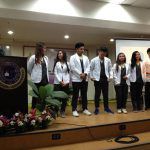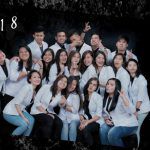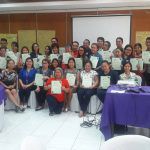Liberty to Learn. The exercise of Academic Freedom. The liberty to explore, innovate, to advance the search of knowledge.
These are the words that appear in your student handbook.
What exactly is academic freedom? What does the exercise of academic freedom entail?
The 1987 Philippine Constitution, specifically Article Fourteen (XIV)(Education, Science, and Technology, Arts, Culture and Sports.)
Section 5. #2. States that“Academic freedom shall be enjoyed in all institutions of higher learning.”While this states the desired policy direction for government administrators, it falls short of defining what academic freedom means.
Let me try to share with you my own thoughts on academic freedom. I shall start with my own definition of this term.
Academic freedom is the freedom of an academic institution through its faculty, researchers and students to search for the truth (thus, research), and to pursue knowledge (thus, teach and study), wherever it may lead without unreasonable interference or restriction from the state, church or public pressure.
I emphasize the freedom of the academic institution because one has to be in an academic institution to have the right to academic freedom. Academic freedom is enjoyed in the context of an institution of higher learning, not in corporations or NGOs,
“Academic freedom” includes the freedom to seek the truth where it may be found, and to pursue knowledge in order to increase the flow of information and understanding in the world. It also includes the power to shape knowledge as a source of power.
Michel Foucault once said that “The university and in a general way, all teaching systems, which appear simply to disseminate knowledge, are made to maintain a certain social class in power, and to exclude the instruments of power in another social class”.
The search for truth, the continuous uncovering of hidden ideas is essential to the mission of any educational institution, of whatever level of learning. If we stop, and do not improve or change what we teach, we help to propagate the status quo, and therefore help any existing powerful group to maintain its power.
In the Philippines, there once was a time when our history books were written from the perspective of the Spaniards and the Americans. For many decades, our children studied that Magellan discovered the Philippines. Did he really? He became the discoverer only because he was the first Foreigner who claimed it with a sword. Many years before the Spaniards came, headed by the Portuguese Magellan, the Chinese, and some historians even say, the Dutch, were trading with us regularly.One antique collector I know, does not consider artifacts that are from the Spanish times as antique. He considers antique those that are from the 10th century or older. In his collections, one will find Chinese vases from the 8th and 9th century. He found them in burial grounds in the Ilocos and Bohol. He has a collection of celadon plates and dishes from the Han and Shang Dynasty of the 3rd Century.
In this example, the knowledge about history of a generation of Filipinos, were defined by the perspective of our ruling elite who were direct descendants of our conquerors.
Randy David once said, “As a right to be enjoyed by the university itself, academic freedom meant the university’s right to determine for itself, solely on academic grounds, who may teach, what may be taught how it shall be taught, and who may be admitted to study. The enjoyment of that freedom depends in large measure on the capacity of the institution to draw its sustenance from society in return for performing a role in the social division of labor, while protecting its academic prerogatives from intervention by the dominant institutions of the same society – in particular, the church and the state (Randy David, 2008, Modernity and the University).
REALITY is almost always defined by the dominant group. Sometimes, we may perceive a different reality from what our colleagues perceive. We see a different version of the truth. Because seeing truth is like looking at a prism and depending on the light.
In the advocacy for gender fairness, the struggle is when we try to make our colleagues understand, that their taken for granted reality may not be our reality. Family structures have changed across time. The definition of the family of tatay, nanayanak, is no longer the same.
It is only when we render the status quo as problematic that we are able to find the best version of or communities and ourselves. As Japanese philosophy KAIZEN would say, a state of continuous improvement.
Through academic freedom – students and teachers can discuss freely without fear of censorship or retaliation. We can preserve the intellectual integrity of our institution and maintain our academic standards. We can challenge one another’s views but we should not penalize the other for holding a different view.
Academic freedom does not mean faculty can harass the students or students cannot be required to have mastery of their subjects. The curriculum belongs to the institution, not the faculty and thus have certain standards that must be upheld. The admission process belongs to the institution, not the faculty. Academic freedom is a product not only of individual academic research but of vigorous, sustained intellectual exchange and dialogue among scholars and non-academics, a free and open exchange of ideas.
The authority to define and enforce academic freedom lies with the institution, as long as it is explicitly stated in writing at the time of employment. However, your freedom ends where my nose begins.
How do we practice academic freedom?
in the context of academic life, academic freedom is practiced in the
grant of tenure to the faculty and the protection of the faculty, researchers and students in their exercise of academic freedom inside and outside the classroom.The faculty as a collective, not just the individual faculty, through a collegial decision-making process, is given primary responsibility in the application of academic freedom.
While students also have academic freedom. They cannot dictate to the faculty their own curriculum and how it should be taught. When they enter the university, they are submitting themselves not only to the standards of and rigors of academic excellence but also to the values of social responsibility taught by the faculty.
What is the price of academic freedom?
1) Time – to think, to create, to study
2) Energy – continuous improvement
3) Passion – zest the desire to engage in discourse, to exchange ideas.
4) Creativity – to innovate, not the same idea all the time, but a progressive, dynamic search for ideas.
Academic freedom has a price. The liberty to explore, to innovate, to advance the search for knowledge may cost us our lives, our families, our friends, if we stand by our right to seek the truth and to continuously seek a better way of life for ourselves and society. So, stand and be courageous.
Finally, my friends, keep your minds on whatever is true, pure, right, holy, friendly, and proper. Don’t ever stop thinking about what is truly worthwhile and worthy of praise.






